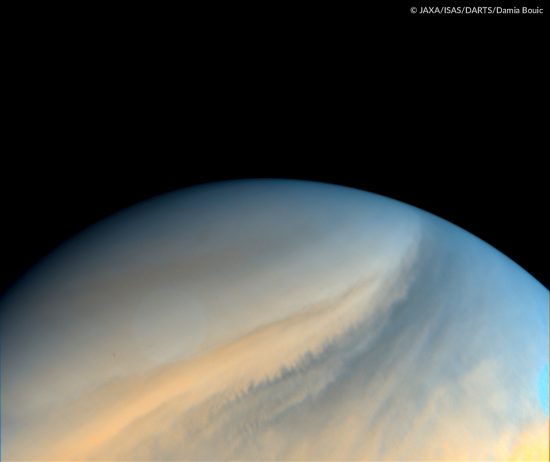
False-color image of Venus’ south pole in ultraviolet. Credit: JAXA / ISAS / DARTS / Damia Bouic.
Jul 30, 2018
Goddess-like beauty scarred forever.
There are indications that Venus underwent a catastrophic event (or events) sometime in the recent past. Giant cracks extend for hundreds of kilometers, for example. Those fractures are accompanied by “coronae”, with deep channels branching out like carved lightning bolts. Vast caldera with upraised rims and glassified, crazed interiors dominate the landscape.
Planetary scientists believe that volcanic upwelling melted and swelled the surface. When it subsided, the magma cooled and contracted, leaving behind a network of fractures. Those processes are what they believe formed the coronae. However, in an Electric Universe, those formations resemble lightning scars.
In previous Pictures of the Day about Venus, those structures are described as electric discharge events. Since geological feature should not be viewed in isolation, there are craters with wide, flat floors and steep sidewalls to consider. There are also terraced; sinuous canyons with vertical walls, scalloped edges, no outflow debris, and flat bottoms. There are mesas with forty-five degree “shoulders” and escarpments that are cut by parallel grooves; faults with no sign of strike-slip, with other faults cutting across them at ninety degrees.
Shield volcanoes and pedestal craters are visible through the clouds. Such geology is difficult to explain, unless electrical activity is invoked. Gigantic plasma discharges pull material toward them into the center of a vortex. After an electric arc passes, a raised mound of debris, often with a moat, remains. Some mounds, like Eistla Regio, can be very large.
Probably the most important aspect about Venus is its anomalous electric field. Electric Universe advocate, Wal Thornhill is sure that the raised mounds and the mountain tops on Venus are electrically energized:
“…diffuse electric discharge, known on Earth as ‘St. Elmo’s fire’, occurs preferentially at the higher altitudes of the mountains on Venus. In that thick atmosphere it forms a highly conductive dense plasma, which is a superb reflector of radar signals. The density of the atmosphere at the surface of Venus is about 1/10 that of water. St. Elmo’s fire is a highly ionised state involving actual discharge. Put the two together and you have dense plasma – which conducts like a metal and therefore reflects radar like a metal surface.”
This explains why some areas on the surface are so reflective to radar: St. Elmo’s Fire is a plasma phenomenon, similar to static electricity, and charged plasma reflects radar like a mirror.
How Venus was formed and how its blasted and burned surface came about must include electricity’s power. Its high density atmosphere generated highly energetic discharges that left the aforementioned deep trenches and structures called, arachnoids scattered across its surface. Plate tectonics does not account for all the unusual terrain on Venus. A better theory considers increased electrical activity throughout the Solar System in the recent past as a viable factor. It accounts for the terrain, the electromagnetic field, the temperature variations, the polar vortices and many other phenomena, not just on Venus, but on other bodies in the Solar System.
Stephen Smith












